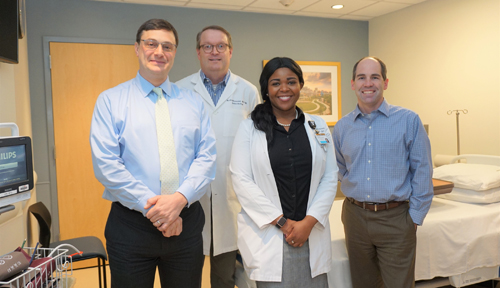For several years Vanderbilt University Medical Center researchers have been studying adipose tissue to help unlock the mysteries behind metabolic disorders related to obesity, cardiovascular disease, diabetes and other health conditions, and now they have a new resource to support their investigations.
The Human Metabolic Physiology Core (HMPC), overseen by Kevin Niswender, MD, PhD, director of VUMC’s Clinical Research Center (CRC) and associate professor of Medicine, will provide minimally invasive biopsies of human adipose tissue, with bedside sample processing. Future planned services include biopsies for muscle and skin tissue, as well as glucose and insulin clamp tests. Procedures are performed in either the CRC in Medical Center North or at Vanderbilt Health One Hundred Oaks.

“Adipose tissue is a gold mine in terms of understanding metabolic disease, and to be able to have a method to access it that is so well tolerated and that is relatively easy to do is part of the reason this core has come to life,” said Niswender. “Nashville is the epicenter of the obesity and diabetes epidemics, so to have a fundamental technique that could lead to important discoveries will position us, in the long run, to improve health in our local area, as well as regionally and nationally.”
Adipocytes or fat cells play a vital role in the storage and release of energy throughout the human body, but adipose tissue is also an important component of the body’s endocrine system. Cells found in adipose tissue produce hormones that aid in the regulation of glucose and lipids, and adipose is an important source of metabolically unhealthy inflammation.
John Koethe, MD, MSCI, assistant professor of Medicine, and Matt Luther, MD, associate professor of Medicine, will serve as associate directors for the new core. LaToya Hannah, MSN, APRN, previously in the VUMC Surgical Intensive Care Unit, will serve as the lead proceduralist to collect tissue samples from study participants. While adipose had been collected for VUMC studies in the past, the formation of the new core with dedicated staff will both increase the number of samples that can be collected, as well as standardize the process, Koethe said.
“It’s not until we can actually collect the adipose tissue itself that we can undertake a lot of the studies of energy metabolism, glucose metabolism and metabolic fitness that are needed to really uncover the pathogenesis of metabolic diseases like diabetes,” Koethe said. “Over the past several years, there have been many investigators conducting studies requiring the collection of adipose tissue. It became clear that we needed to standardize our approach and optimize both the biopsy procedure, in terms of participant safety and comfort and also in terms of yield, to really put in place best practices.”
The minimally invasive biopsies are performed using liposuction in the abdominal area, then processed and delivered to the investigator’s laboratory.
“It’s done at the bedside with a local anesthetic, does not require any stitches and generally does not leave any mark on the skin,” Hannah said. “Usually people are very comfortable and carrying on conversations with us during the procedure.”
The core is supporting the five-year, NIH-funded HIV, Adipose Tissue Immunology and Metabolism (HATIM) study that examines whether chronic activation of the immune system that persists in patients with HIV, despite effective virus suppression, contributes to adipose tissue dysfunction and an increased risk of diabetes.
“HIV-infected individuals can now survive decades on antiretroviral therapy, but this success has been accompanied by an increasing burden of metabolic disease, including diabetes, in the HIV patient population,” said Koethe, principal investigator for HATIM study. “The incidence rate of diabetes for individuals with HIV is approximately twice what we would expect with normal risk factors.
The goal of this study is to improve our understanding of how immune cells in adipose tissue affect glucose metabolism, and help design future therapies to reduce the prevalence of diabetes in both HIV-infected persons and the general population.”
Nancy Brown, MD, chair of the Department of Medicine, is another VUMC investigator working with the new core for an investigation on the effects of a class of drugs known as glucagon-like peptide-1 receptor agonists on vascular function, inflammation and cardiovascular risk. Her study is part of the American Heart Association’s (AHA) Strategically Focused Obesity Research Network and is funded by the association.
“This resource will greatly enhance our ability to study mechanisms of obesity and insulin resistance safely,” said Brown.
The HMPC falls under the Metabolic Physiology Shared Resource (MPSR) of the Vanderbilt Diabetes Research and Training Center (VDRTC) and is supported by the VDRTC’s National Institutes of Health (NIH) P30 grant.















